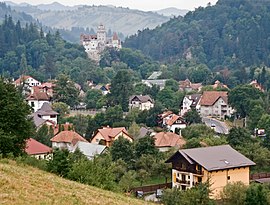Bran, Brașov
Bran | |
|---|---|
 | |
 Coat of arms | |
 Location of Bran within Brașov County | |
 Bran Location in Romania | |
| Coordinates: 45°30′41″N 25°21′51″E / 45.51139°N 25.36417°ECoordinates: 45°30′41″N 25°21′51″E / 45.51139°N 25.36417°E | |
| Country | Romania |
| County | Brașov |
| Government | |
| • Mayor (2020–2024) | Cosmin Feroiu[1] (PNL) |
| Area | 67.85 km2 (26.20 sq mi) |
| Population (2011)[2] | 5,181 |
| • Density | 76/km2 (200/sq mi) |
| Time zone | EET/EEST (UTC+2/+3) |
| Vehicle reg. | BV |
| Website | www |
Bran (German: Törzburg; Hungarian: Törcsvár) is a commune in Brașov County, Transylvania, Romania. It is about 25 kilometres (16 mi) southwest of the city of Brașov and consists of five villages: Bran, Poarta (Hungarian: Porta), Predeluț (Kispredeál), Șimon (Simon) and Sohodol (Szohodol). It is included in the historical sub-region of Burzenland.
The medieval Bran Castle is a popular tourist destination, partly because it is associated with the home of Dracula in Bram Stoker's novel of the same name.[3]
History[]
The Teutonic Order began building a wooden fort called Dietrichstein here early in the 13th century. After the fort's destruction in 1242 by Mongols, King Sigismund of Hungary ordered the a stone castle to be built in 1377, while the settlement of Bran began to develop nearby. Positioned high atop a steep cliff, the castle guarded a strategic trade route between Transylvania and Wallachia. In 1498, Bran came under the jurisdiction of Braşov.[4]
After the Ottoman Empire defeated the Kingdom of Hungary in the 16th century, Bran became part of the Eastern Hungarian Kingdom and the Principality of Transylvania which eventually became part of the Habsburg Monarchy. In 1804 the commune became part of the Austrian Empire along with the Grand Principality of Transylvania and in 1867 the Hungarian-half of the Austro-Hungarian Empire. It was added to the Kingdom of Romania following World War I.[5]
Bran Castle is one of Romania's most popular visitor sites, made famous in modern times when Queen Marie restored it after receiving it from the residents of Brașov County in the 1920s. The castle is open to tourists, who can view the inside alone or as part of a guided tour. Outside the castle are examples of traditional Romanian farm houses and peasant homes.
References[]
- ^ "Results of the 2020 local elections". Central Electoral Bureau. Retrieved 9 June 2021.
- ^ "Populaţia stabilă pe judeţe, municipii, oraşe şi localităti componenete la RPL_2011" (in Romanian). National Institute of Statistics. Retrieved 4 February 2014.
- ^ Light, Duncan (2012). The Dracula Dilemma: Tourism, Identity and the State in Romania. Farnham: Ashgate Publishing. ISBN 9781409456285.
- ^ Belanger, Jeff (2006). Ghosts of War: Restless Spirits of Soldiers, Spies, And Saboteurs. Career Press. ISBN 9781564148896.
- ^ Smith, Laurajane; Waterton, Emma; Watson, Steve (2012). The Cultural Moment in Tourism. Routledge. ISBN 9781136831539.
- Communes in Brașov County
- Localities in Transylvania
- Burzenland


